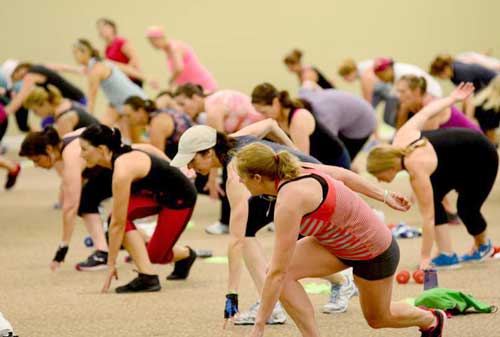If you have limited time to work out, every second counts. Mindlessly going through the motions isn’t the best way to use your time or deliver the kind of results you’re looking for. Why waste your workout minutes? Here are seven workout tips to help you get the most out of every workout.
Engage Your Abs during Every Exercise
What does it really mean to engage your abs? Focus on pulling your belly button in and up when you do each exercise, even when you do non-ab focused exercises like squats. It’ll give you more six-pack action. Recruiting your abdomen muscles during every exercise burns more calories and reduces your risk for injury too. That’s what a strong core is for – to protect you from injury and lower back pain.
Put your abs to work when you’re doing any type of exercise. Even when you’re at your desk at work, focus on engaging your abs by pulling your belly button in toward your spine to improve your posture. You’ll get more out of each exercise if you keep your abs engaged from the first rep to the last.
Focus on Your Form
After you’ve done a routine for a while, it’s easy to let your form slip. Factors like proper body alignment, time under tension, speed and the range of motion you use directly affect the success of an exercise. Watch yourself in the mirror as you do your reps to make sure you’re using proper form. Focus on the muscles you’re working instead of letting your mind wander. When you use improper form, you recruit secondary muscles. This takes some of the workload off the muscles you’re trying to fatigue. Bad form also increases your risk of injury. Make every repetition count to get the most out of your workout.
Keep Moving Between Exercises
To maximize calorie burn when you’re strength training, keep your feet moving between exercises. Jog in place or by doing some other form of light activity. Circuit training is another way to maximize the benefits you get out of a workout. Moving from exercise to exercise with minimal rest gives cardiovascular benefits while you’re building muscle strength or endurance. It also maximizes calorie burn. Keep your body moving the whole time you’re working out.
Multi-Task Your Workout
Make the best use of your workout time by doing more compound exercises. Compound exercises are ones that work more than one major muscle group at the same time, usually upper and lower body muscles. An example: doing overhead presses while you squat. Why bother doing this? You get more bang for your fitness buck because you’re working upper and lower body at the same time AND you burn more calories because you’re working more muscle fibers. Try to recruit the most muscle fibers with each exercise when your time is limited.
Find Your “Best” Time to Work Out
Choose your workout time carefully. If you’re a morning person you may be most motivated and productive as soon as the sun comes up. If you have trouble dragging yourself out of bed and can’t function until you’ve had three cups of coffee, exercising later in the day might be a better option. There are advantages to each.
Your body temperature is highest at around 5:00 P.M. That makes it a little easier to work out later in the day. But exercising in the morning is psychologically satisfying, knowing you got it done – early. Plus, it’ll give you more energy to tackle your day. Try it both ways and see which works best for you. You’ll put more effort and motivation into a workout if you exercise at a time that’s right for you.
Monitor Your Progress
Track your progress by keeping a training log. This makes it easier to see how you’re progressing and when you need to make changes – like increasing the weight. You aren’t maximizing your results if you’re doing the same exercises at the same intensity every time. It’s all about progressive overload – gradually increasing the stress you place on your muscles so they grow and adapt. Keeping a training log is a good motivation tool too. Set workout goals every week so you have something to focus on during your workouts to keep your mind from wandering.
Take a Break
When you don’t take days off your workout performance will eventually decline so you’re getting fewer results. A day off at least once a week gives your body time to recover. Why not use one day per week as a “passive rest” day where you do no formal exercise? Choose another as an “active rest” day. Use this day to do a low-intensity workout. It’s your chance to do a yoga DVD or a low-intensity step workout. You can even try a workout you haven’t done before. We all need variety! By doing this, you’ll approach your next high-intensity session with more enthusiasm. Your risk of injury will be lower too since you’re giving your muscles time to rest and recovery.
The Bottom Line?
The minutes you spend working out should be productive ones. Make the most out of every minute and every exercise so you end your workout feeling satisfied. Think about the times you didn’t put everything into it. How did you feel when you were finished? Probably not as good as you should have. Use these workout tips to keep your workouts as productive and effective as possible.
References:
Exercise Physiology: Theory and Application to Fitness and Performance. Howley and Powers. Seven edition.
Related Articles By Cathe:
5 Ways to Make Bodyweight Exercises More Effective
How to Fit in a Workout Even When You Have No Time
5 Time Expedient Exercises That Will Power Up Your Fitness Routine
Do You Need to Do Isolation Exercises?


